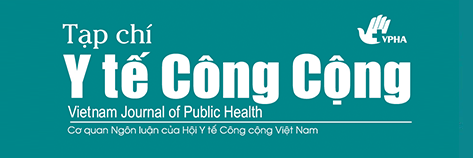Nghiên cứu sinh thái về một số đặc điểm của xã đến bệnh mắt hột hoạt tính ở trẻ em (Factors associated with active trachoma in children at commune level in Vietnam: An ecological study)
Tóm tắt
Mắt hột là một trong những nguyên nhân hàng đầu dẫn đến các tổn thương ở mắt và mù lòa có thể phòng ngừa được. Ở Việt Nam, bệnh phân bố không đều. Mắt hột hoạt tính chủ yếu tập trung thành cụm ở mức xã hoặc mức thôn. Bộ Y tế đã đặt ra mục tiêu thanh toán mắt hột vào năm 2010. Nghiên cứu này xác định mối liên quan giữa tỉ lệ mắt hột ở trẻ dưới 10 tuổi và một số đặc điểm về kinh tế xã hội, vệ sinh môi trường. Kết quả nghiên cứu cho thấy đặc điểm kinh tế- xã hội như xã có tỉ lệ hộ nghèo cao, thu nhập bình quân đầu người thấp, đường giao thông trong xã không thuận lợi là những yếu tố nguy cơ tiềm tàng làm tăng tỉ lệ mắt hột hoạt tính ở trẻ; các yếu tố vệ sinh môi trường như hộ gia đình sử dụng nước sạch, hộ gia đình sử dụng hố xí tự hoại, hộ gia đình đổ rác ra bãi rác công cộng và sự sẵn có của bãi rác công cộng trong xã là những yếu tố có liên quan góp phần làm giảm tỉ lệ mắt hột trẻ em.
English abstract
Trachoma is one of the leading causes of preventable vision loss and blindness. In Vietnam, trachoma is not evenly distributed. It is mainly clustered within commune or village. Vietnam Ministry of Health has set the objective of eliminating trachoma by 2010. As an ecological design, this study identified the potential associations between the prevalence of trachoma among children aged under 10 and characteristics of commune such as socio-economic status, environmental and hygiene factors. The study's results show that socio-economic factors such as high proportion of poor households, low income per capital, and commune's poor traffic roads are potential risk factors which increase the prevalence of trachoma in children; environmental and hygiene factors like households using fresh water, households using flush toilet, households dumping rubbish into public dumping ground and the availability of public dumping ground in the commune are protective factors contributing to lowering the prevalence of trachoma in children.
Từ khóa
Toàn văn:
PDF (English)##submission.citations##
Kasi P et al., Blinding trachoma: A disease of poverty. PLOS Medicine, 2004. 1(2): p. e44.
Dolin PJ et al., Trachoma in Gambia. British Journal of Ophthalmology, 1998. 82: p. 930-933.
Arab GE et al., The burden of trachoma in the rural Nile Delta of Egypt: a survey of Menofiya governorate. British Journal of Ophthalmology, 2001. 85: p. 1406 - 1410.
Cục Y tế Dự phòng và Phòng chống HIV/AIDS, Điều tra dịch tễ học mắt hột tại các tỉnh miền Bắc Việt Nam. 2001.
Denise Mabey, FRCOphth, MBBS. Trachoma. EMedicine, 2001.
Tôn Thị Kim Thanh, Vietnam: Elimination of Blinding Trachoma by the year 2010, in Vietnam country report. 2002, National Institute of Ophthalmology: Hanoi.
Phạm Nguyên Bằng, KAP Survey on Trachoma in 11 districts in North and Central of Vietnam. 2002, International Trachoma Initiative - Preventive Medicine Department, the Ministry of Health.
Nguyễn Chí Dương, Dịch tễ học bệnh mắt hột ở trẻ em dưới 15 tuổi ở một số vùng Việt Nam hiện nay. 1994, Viện mắt trung ương: Hà nội.
Ho VH & Schwabb IR, Social economic development in the prevention of global blindness. British Journal of Ophthalmology, 2001. 85: p. 653-657.
Emerson P.M et al., Review of the evidence base for the 'F' and 'E' components of the SAFE strategy for trachoma control. Tropical Medicine and International Health, 2000. 5(8): p. 515 - 527.
Frick KD et al., Global burden of trachoma and economics of the disease. American Journal of Tropical Medicine and Hygiene, 2003. 65: p. 1 - 10.
Editorial, Blinding trachoma: the forgotten problem. British Journal of Ophthalmology, 2001. 85: p. 1397-1399.
Marx R, Social Factor and trachoma: a review of the literature. Social Science and Medicine, 1989. 29: p. 23-34.
Bogale A & Bejiga A, Environmental risk factors and the development of trachomatous trichiasis in Dalocha District, Central Ethiopia: a case-control study. Ethiopian Journal of Health Development, 2002. 16(3): p. 287-293.
Luna EJ et al., Epidemiology of trachoma in Bebedouro State of Sao Paulo, Brazil: prevalence and risk factors. International Journal of Epidemiology, 1992. 21: p. 169- 177.
Sahlu T & Larson C, The prevalence and environmental risk factor for moderate and severe trachoma in southern Ethiopia. 1992. 95: p. 36-41.
Pruss A & Mariotti SP, Preventing trachoma through environmental sanitation: a review of the evidence base. Bulletin of the World Health Organization, 2000. 78(2): p. 258-266.



